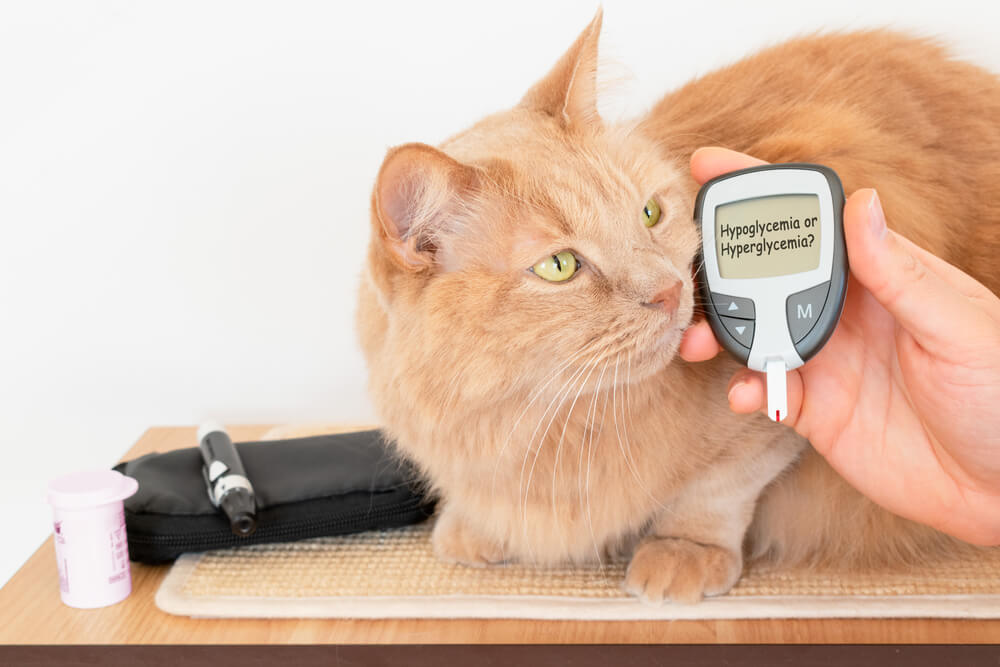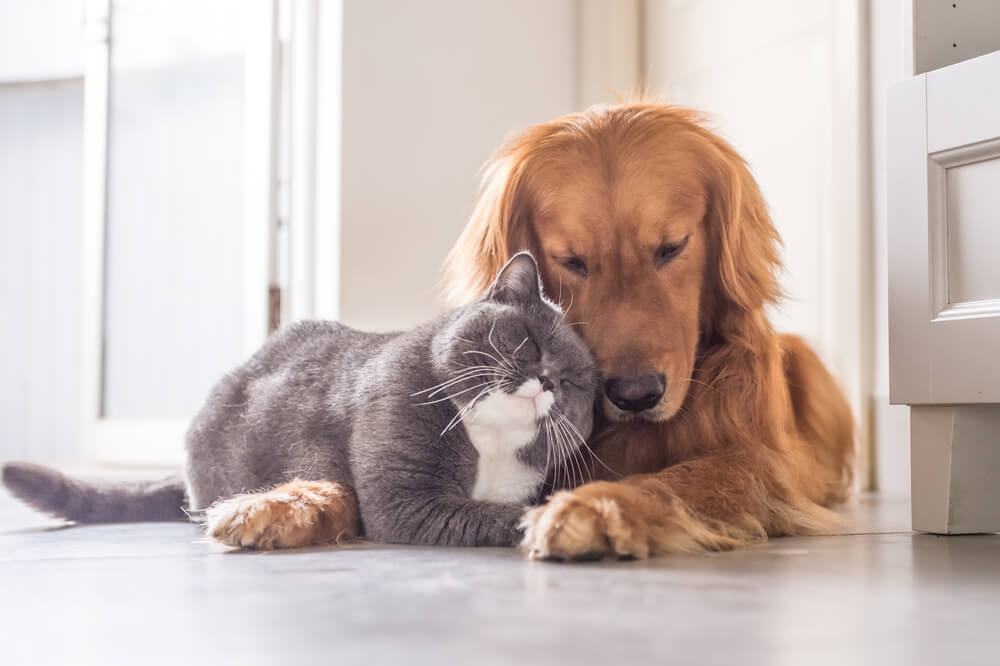
Diabetes in cats is more common than you might think – it’s estimated around 0.2% to 1% of cats will be diagnosed with diabetes mellitus in their lifetime.
This means that it’s worth knowing the signs and symptoms of feline diabetes, and what to do if you think your cat has the disease.
On a positive note, diabetes can be reversible if caught and treated early – so if your cat is showing any signs or symptoms, it’s worth taking them to the vet for an assessment to determine if feline diabetes is on the horizon or has already arrived. And if they are diagnosed as diabetic it might not be as bad as you think…
What is diabetes in cats?
Similar to human type 2 diabetes, feline diabetes mellitus causes cat problems with producing insulin, meaning the pancreas doesn’t make enough of it, or their body doesn’t deal with it properly by transporting the glucose from the blood to the required cells.
This leads to an increase in blood glucose (sugar), which, although crucial for giving your cat energy to chase mice, birds, and whatever toy you wiggle in front of them, if too high,can lead to health problems.
What are the signs of feline diabetes?
If your cat is obese it can be a sign that it has developed, or is developing, diabetes. Overweight or obese cats are up to four times more likely to develop the disease, so controlling your cat’s weight is an important step toward preventing diabetes in the first place.
One sign that your cat might have diabetes is an increase in thirst and urination. This is due to high glucose levels in the cat’s blood resulting in problems filtering it in the kidneys. The glucose then draws excess water into the urine. For comparison purposes, an average cat pees 2-3 times a day, so if your cat is urinating significantly more than that it might be worth taking them to the vet.
Another common sign is your cat loses weight despite eating its normal diet. This is due to the cat not being able to get the energy it needs from glucose in its bloodstream, so its body breaks down fat and protein for energy, resulting in weight loss and ravenous hunger between mealtimes.
Other signs include:
- vomiting
- tiredness and lethargy
- liver enlargement
- loss of coat
A rarer sign is your cat walking with a plantigrade stance – bending the rear legs so it appears they are walking on their ankles. The cat is not in pain, and this can be resolved with treatment.
It’s important to see your vet quickly if you’re worried your cat has diabetes, as if left untreated the diagnosis is poor – potentially fatal – and will likely lead to hyperglycemia followed by diabetic ketoacidosis (see below).
What is a high blood sugar range for cats?
The first thing your vet will do if you’re worried your cat has diabetes is perform a blood sugar test. The normal range for cats is 80 to 120 mg/dL – any higher than this can lead to high blood sugar, also known as hyperglycemia. This can be a sign of prediabetes and, if left untreated, could lead to diabetic ketoacidosis.
This occurs when the cat’s liver begins to break down fat, as the cells lack enough glucose to use as a source of energy. This fat breakdown produces ketones, which if numbers increase to high levels, can lead to health issues.
This is a more serious disease than diabetes mellitus and can be life-threatening if not treated quickly. The survival rate of diabetes ketoacidosis if treated rapidly is around 70%.
What age does diabetes affect cats?
Cats older than 5 years of age are more at risk of diabetes, although it can be diagnosed in cats of any age.
Are certain breeds more prone to diabetes?
Tests have shown that some breeds, including Burmese, Tonkinese, Russian Blue, Abyssian, and Norwegian Forest cats, are potentially more genetically predisposed to diabetes. Also, indoor cats are at higher risk due to lower levels of movement and activity – and the resulting weight gain – when compared to outdoor cats.
Another risk factor is prolonged use of steroids, as well as feeding your cat too much ‘human’ food, which can affect the pancreas’s ability to produce insulin.
How is diabetes in cats diagnosed?
The two most common tests for diabetes in cats are a urine test and blood test. Both will be tested for glucose levels, and if the results are high it’s a sign it may be diabetes.
Your vet may need to do further tests to confirm whether or not it is diabetes, as factors such as stress and other conditions may also elevate a cat’s glucose levels.
What medication is required for a cat with diabetes?
The good news is that if it’s picked up and diagnosed early, your cat has a high chance of responding positively to treatment and, like with humans, reversing the diagnosis.
Once diagnosed with diabetes, the most common treatment is insulin injections, usually twice a day. These can be administered at home 12 hours apart, under the skin at the scruff of the neck, which is painless for your cat.
Giving your feline friend an injection can be daunting at first, but you will quickly get the hang of it – although you might need an extra pair of hands to help hold your cat still while you administer the jab.
It’s also likely that you will be required to learn to test your cat’s blood glucose levels via simple blood-testing kits provided by your vet.
As with any long-term treatment, the costs can add up. As a rough guide, you might expect to pay anything from $30-$100 for insulin every 40 days, with the cost of injection pens around $150 (an alternative to syringes). You will also require blood-testing kits, which can be $25-$50, plus vets’ fees on top.
Should you change your cat’s diet?
If your cat is overweight, losing a few pounds is key to successfully controlling diabetes. Speak to your vet for advice about what you should and shouldn’t feed your diabetic cat – although, in general, reducing carbohydrates will be the first step. To help with this, wet food is recommended over kibble, as kibble can have higher levels of carbohydrate content. See our page on the best cat food for diabetes to help you.
Exercise is also important, so ensure you keep your cat active, play games with them, and make sure they aren’t lying on the sofa all day eating snacks (like you used to when you took a sick day off school).
How soon will you begin to see an improvement?
For many cats (estimates are put at around 30%-40%), the outlook is good and they will begin to improve quickly once they begin insulin injections and a change in diet, especially if the treatment begins early, leading to remission of the disease.
Remission usually happens within six months of starting injections. If your cat does not respond to therapy in this time, it’s likely to be a lifelong condition requiring daily insulin injections and regular monitoring by your vet.
We uphold the highest editorial standards when creating the authoritative content pet parents rely on and trust.
Every piece of clinical content on the Cat Food Advisor is reviewed by our certified Veterinary Advisory Board, which consists of licensed veterinarians and medically certified specialists.
Our reviews are completely independent; we are not paid by any pet food company to promote their products favorably. We do not accept money, gifts, samples or other incentives in exchange for special consideration. For more information see our Disclaimer & Disclosure page.










